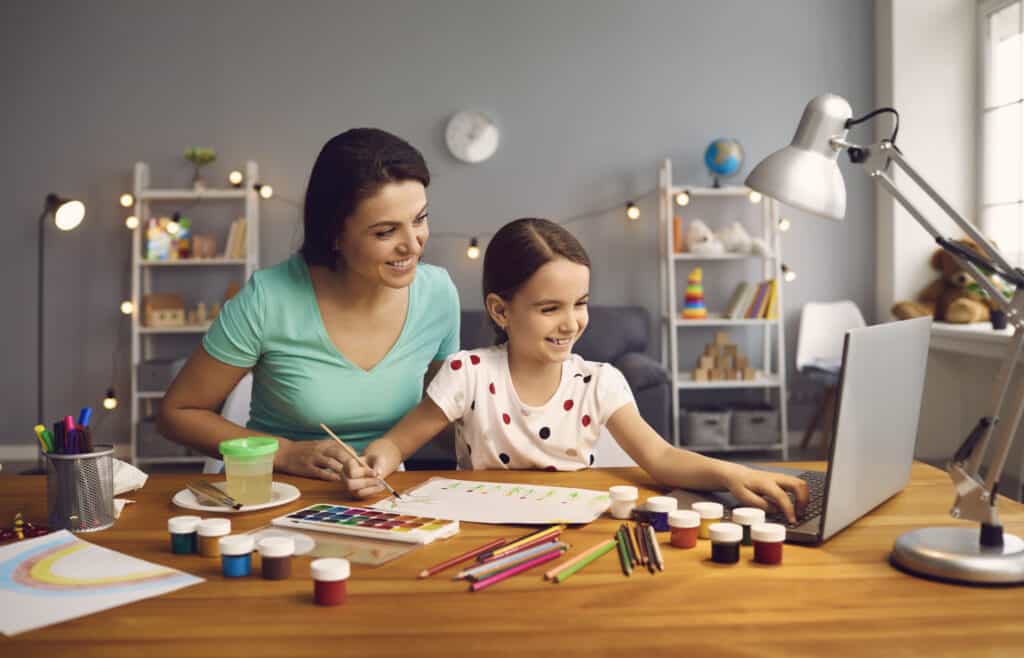Have Happier Children By Limiting Electronic Devices
In today’s hyper-connected digital age, keeping children completely away from screens is virtually impossible. Unfortunately, screen time has become integral to their lives, whether for education, entertainment, or social interaction. However, this doesn’t mean all screen time must be passive or unproductive. There are numerous ways to transform this often-maligned aspect of modern childhood into something far more meaningful and beneficial. Delve into the various ways to make screen time more meaningful for kids and transform it from a mindless pastime into an enriching experience that contributes to their overall development.
Reducing screen time helps children regulate their emotions better. According to the latest research, children with limited screen time are generally happier.

Tips for Making Screen Time More Meaningful
1. Switch Up the Subtitles and Audio Language
Experimenting with subtitles and audio languages can be a fun and effective way to introduce children to new languages. Switching a movie’s audio language to a foreign language and keeping the subtitles in a language your child is familiar with can help them naturally pick up on new words and phrases. This method can be particularly effective with animated movies or series that the child enjoys and is familiar with. Watching Disney movies in Spanish is a great way to ease into this change in screen time, as it allows your children to enjoy their favorite movies still while also teaching them something new. It’s a subtle way to incorporate learning into leisure time, enhancing your child’s linguistic abilities while they enjoy their favorite shows.
2. Incorporate Physical Activity Into Screen Time
Screen time doesn’t have to mean sedentary time. There are plenty of interactive games and apps available that encourage physical activity. Dance-along videos, virtual reality sports games, or fitness apps designed for kids are great ways to make screen time more meaningful, engaging, and physically stimulating. These apps often combine vivid animations and entertaining narratives to encourage children to move, jump, dance, and stretch. Not only does this help maintain a healthy balance between digital and physical play, but it also promotes physical health and coordination.
3. Choose Video Games That Teach Valuable Skills
Not all video games are created equal. As such, it’s essential to choose games for your kids that offer more than just entertainment value; look for games that can also teach valuable skills. Many games on the market are designed with education in mind, teaching everything from basic math and reading skills to more complex subjects like coding and problem-solving. These games often incorporate these lessons into fun, engaging narratives that keep children interested and motivated. By selecting these types of games, you’re turning screen time into a learning opportunity while your child is having fun.
4. Host Family Movie Nights With a Message
Family movie nights are a great way to make screen time a shared, meaningful experience. But beyond providing entertainment, these movie nights can also serve as a platform for imparting important life lessons. Choose films that have a solid moral or message and discuss them afterward. This could range from themes of friendship and courage to more complex topics like diversity and social justice. Choosing such movies allows you to open up a dialogue with your children, hear their thoughts, and share your insights. Not only does this promote critical thinking, but it also strengthens family bonds, making screen time an occasion for connection and conversation..
5. Pick a Book/Movie Combo
Find a movie based on a book such as Willy Wonka and the Chocolate Factory, Mary Poppins, Mr. Popper’s Penguins, or Pinocchio, and read the book. After reading the book out loud, watch the movie and have a themed dinner around the book and movie. Make sure to discuss the differences from the book to the movie.
6. Choose Content Carefully
Be very intentional with the content when deciding what screen time you will allow. Look for movies, games, and social media that incorporate your fundamental values and characters that engage your children and are favorites for the entire family.
7. Set Aside Times for Screens
Change too much screen time into a set amount for everyone in the house. From young children to older children (and even mom and dad), limit screen use at home. While we can’t get away from screens in our work and school, being a good role model at home will set your children up for success later in life.

8. No Screen Time at the Dinner Table
This tip is one that everyone should adhere to. Make the dinner table family time. Sit at the table and not in front of a screen. If you can’t think of anything to discuss with your family members at dinner, start with these dinner-time conversation starters.
9. Learn to Touch Type
While we think everyone knows how to type because they are with digital devices all the time, research suggests that less than 20% of us can actually touch type. This is a skill that is incredibly useful to have. My older kids all took Mavis Beacon Teaches Typing, and taking a course is the best way to learn.
10. Set a Timer for Screen Time
If you know (and your kids know) that screen time is limited, you will be more intentional with that time. When you don’t set a timer, you get lost in the mindless scrolling and soon realize that you have spent too much time and never got around to the things you really wanted to focus on during screen time.
11. Use Your Digital Devices as Tools
Too often, we give our children digital devices, viewed as playtime devices, instead of the digital tools they can be. If you teach young children how to use these devices in the real world, they will begin to respect them as a valuable resource. Start with timers, clocks, and calendars to keep track of schedules.
12. Select Games that Double as Educational Content
Have your children play online strategy games or word games. They won’t realize they are learning and stretching their brains, but kids of all ages will enjoy this content.
13. Reward Smart Screen Use
Start a monthly reward system for smart screen use. If your kids adhere to the Family Media Use Plan you have set up, reward them with special treats or a new board game. Monitoring your child’s screen time is not only recommended by the American Academy of Pediatrics, but it makes sense.
14. Instead of Texting Grandma or Their Favorite Cousin, Set Up a Zoom Call
While everyone seems to have smartphones and texting has become so easy, set up a Zoom call instead. These face-to-face interactions help your young children learn how to interact with real people and help them use digital devices in multiple ways.
15. Find Some Fun Documentaries
Children love good documentaries or nature shows. My son loves to watch DisneyNature films. These educational real life movies teach children about the world around them while satisfying their desire to watch television.
16. Watch Live Feeds to See the World
Do you remember watching April the Giraffe because she was due to give birth? There are a lot of live feeds that depict nature from zoos, aquariums, and even eagle’s nests. These can be educational and fun to watch too.
17. Take Up On Online Hobby
Do you want to learn how to paint? Watching Bob Ross videos while painting can be a family affair. Want to teach cooking? Find some great cooking YouTube videos. Have the whole family take up a new hobby and have fun together.

18. Start a Family YouTube Channel
The online world is here to stay. While some people want to be an internet sensation, most of us want to help children navigate online spaces. You can have a family YouTube channel without showing your children’s faces. Researching, planning, business skills, videoing, and editing are all great skills to learn. It is a great way to learn more about digital technology.
19. Have the Children Design Photo Books
You know all the photos we keep taking and do nothing with? Don’t just leave all your precious memories in the digital world. Have your children design some photo books, and give those books to grandma!
20. Use What They are Learning in School to Select Movies and Shows
If your children are studying the pyramids in school, watch Prince of Egypt or if they are studying Newton’s Laws, watch Disney Imagineering Newton’s Laws. This helps blend what they are learning with what you are doing outside of learning. This use of screens is just smart.
21. Play a Board Game Over Face Time
Sometimes you can’t visit friends because someone is sick or distance prevents it. Playing a board game is fun and exciting over Facetime. You can play games such as Uno, Yahtzee, Boggle, or Battleship.
What are your children pestering you about?
Do you have children asking for an axolotl or wanting to play soccer? Have them write a persuasive paper on why you should let them get their favorite pet or play a new sport. If these are important activities, they will research and write about them. Screen time is international; the writing is practice for adulthood, and they may learn how to craft a compelling argument.
Unless you have been living under a rock, you know that setting screen time limits is just a wise thing to do. You want to have the best parent-child relationships and spend quality time with your kids. However, many children grow to resent parents who place limits on them. Setting a good example and teaching your kids about the safe use of screen time will have a significant impact on them all the days of their lives.


Reviewing movies for parents from a Christian perspective since 2005. Know Before You Go!
Christian Homeschooling mom – 30 years and counting
Autism Mom & Disney enthusiast
